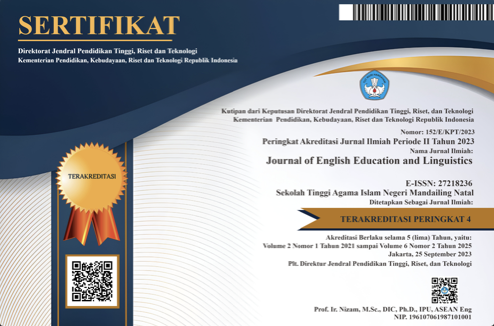CONTRASTING GENDER BIAS LANGUAGES IN PHILIPPINES AND U.S ONLINE NEWS ARTICLES: A CORPUS-BASED STUDY
DOI:
https://doi.org/10.56874/jeel.v3i1.816Keywords:
Corpus-based Study, Contrastive Rhetoric, Gender-biased Languages, Online News ArticlesAbstract
This study aimed to explore the most prevalent gender-biased languages and to identify what type of rhetorical devices were used frequently in the Philippines and U.S Online News Articles and to highlight the similarities and differences of rhetoric taken from ten online news websites. The corpus is made up of 20 articles per news outlet which are GMA News, Manila Bulletin, Manila Times, Rappler, and Philippine Daily Inquirer from the Philippines. Politico, LA Times, The Guardian, USA Today, and CBN News from US. All news was contrastively analyzed based on Robert Kaplan’s Theory of Contrastive Rhetoric using AntConc software. The findings revealed that there are rhetorical devices found in these articles to filter the used labels for males and females that invoke stereotyping. Results also revealed that both countries are similar in terms of using positive and nice words subtly on describing women. However, a vast contradiction is also depicted due to the fact that news writers utilize words that negatively connote and has a sharp definition that is associated with women. Thus, the study concludes that there should be widespread information and practice about the usage of Gender Fair Language in various professions most especially in Media and Journalism.
References
Añonuevo, C. A. (2000). An Overview of the Gender Situation in the Philippines. Diambil kembali dari https://library.fes.de/pdf-files/bueros/philippinen/50069.pdf
Aull, L. (2013, November 6). Corpus Linguistics of Written Language: How ot use "I" and more. Diambil kembali dari Digital Rhetorics Collaborative: https://www.digitalrhetoriccollaborative.org/2013/11/06/using-corpus-linguistic- analysis-of-writing-with-students/
Baranowski, M. (2002). Current Usage of the Epicene Pronoun in Written English. Journal of Sociolinguistics. doi: https://doi.org/10.1111/1467-9481.00193
Bordalo, P., Coffman, K., Genaiolli, N., & Shleifer, &. A. (2019). Beliefs about Gender. American Economic Association. doi:10.1257/aer.20170007
Brunet, M.-E., Alkalay-Houlihan, C., Anderson, A., & Zemel, R. (2019). Understanding the Origins of Gender Bias in Word Embeddings. International Conference on Machine Learning, 803-811. Diambil kembali dari https://arxiv.org/pdf/1810.03611.pdf
Dacon, J., & Liu, H. (2021). Does gender mmatter in news? Detecting and Examining Bias in News Articles. Diambil kembali dari Michigan State University: http://cse.msu.edu/~daconjam/downloads/IC2S2Poster.pdf
England, P., Levine, A., & Mishel, E. (2020). Progress toward gender equality in the United States has slowed or stalled. doi:https://doi.org/10.1073/pnas.1918891117
Guzmán, L. D. (2018). Fake or Visual Trickery? Understanding the Quantitative Visual Rhetoric in the News. Diambil kembali dari https://eric.ed.gov/?id=EJ1198646
Heilman, M. S., & Caleo, S. (2018). Gender discrimination in the workplace. American Psychology Association PsychNet. Diambil kembali dari https://psycnet.apa.org/record/2018-09013-005
Kaplan, R. (1966). TESOL-FRANCE (Contrastive Rhetorc). Diambil kembali dari https://www.tesol-
france.org/uploaded_files/files/TESOL%20V2N2%20C2%20Constrastive%20Rhetori c(1
Kellie, D. J. (2019). What drives female objectification? An investigation of appearance- based interpersonal perceptions and the objectification of women. Pubmed Central. doi: 10.1371/journal.pone.0221388
Lakoff, R. (1975). Language and Women's Place. Diambil kembali dari https://web.stanford.edu/class/linguist156/Lakoff_1973.pdf
Mavin, S., & Grandy, G. (2016). A theory of Abject Appearance: Women elite leaders‟ intra- gender „management‟ of bodies and appearance. Journal.Sage.Pub. doi:https://doi.org/10.1177/0018726715609107
Menegatti, M., & Rubini, M. (2017). Gender Bias and Sexism in Language. Oxford Research Encyclopedia of Communication. doi:https://doi.org/10.1093/acrefore/9780190228613.013.470
Nations, U. (2007). Convention on the Elimination of All Forms of Discrimination against Women (CEDAW). Diambil kembali dari https://www.un.org/womenwatch/daw/cedaw/
Ospina, S. (2004). Qualitative Research. SAGE PUBLICATION.
Pedro, B., Katherine, C., Nicola, G., & Andrei, S. (2019). Beliefs about Gender. American
Economic Association. doi:DOI: 10.1257/aer.20170007
Rodriguez, I. L. (2009). Of Women, Bitches, Chickens and Vixens: Animal. Cultural Studies Journal of Universitat Jaume I. Diambil kembali dari https://core.ac.uk/download/pdf/39085608.pdf
Tabula, R., & Agbayani, R. (2015). Syntactic Patterns of News Headlines in Philippine and American Newspapers. PAIR Multidisciplinary Research Journal. Diambil kembali dari http://ejournals.ph/form/cite.php?id=12415
Zotto, A. C. (2002). Weeping Women, Wringing Hands: How the Mainstream Media Stereotyped Women's Experiences in Kosovo. Journal of Gender Studies. doi:10.1080/09589230220139773
Downloads
Published
Issue
Section
License
All articles published in the Journal of English Education and Linguistics are licensed under a Creative Commons Attribution-ShareAlike 4.0 International (CC BY-SA) license. This means anyone is free to copy, transform, or redistribute articles for any lawful purpose in any medium, provided they give appropriate attribution to the original author(s) and Journal of English Education and Linguistics, link to the license, indicate if changes were made, and redistribute any derivative work under the same license.
Copyright on articles is retained by the respective author(s) without restrictions. A non-exclusive license is granted to the Journal of English Education and Linguistics to publish the article and identify itself as its original publisher, along with the commercial right to include the article in a hardcopy issue for sale to libraries and individuals.
Although the conditions of the Creative Commons Attribution-ShareAlike 4.0 International (CC BY-SA) license do not apply to authors (as the copyright holder of your article, you have no restrictions on your rights), by submitting to the Journal of English Education and Linguistics, authors recognize the rights of readers and must grant any third party the right to use their articles to the extent provided by the license.

This work is licensed under a Creative Commons Attribution-ShareAlike 4.0 International License.








